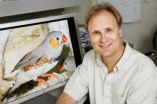(Press-News.org) COLUMBUS, Ohio – The discovery that a bacterial species in the Australian Tammar wallaby gut is responsible for keeping the animal's methane emissions relatively low suggests a potential new strategy may exist to try to reduce methane emissions from livestock, according to a new study.
Globally, livestock are the largest source of methane from human-related activities, and are the third-largest source of this greenhouse gas in the United States, according to the U.S. Environmental Protection Agency.
Wallabies and other marsupials – mammals like the kangaroo that develop their offspring in a pouch – are dependent on microbes to support their digestive system, similar to livestock such as cows, sheep and goats, but Tammar wallabies are known to release about 80 percent less methane gas per unit of digestible energy intake than do livestock animals.
Scientists have used DNA sequence data to devise a way to isolate and grow cultures of a dominant bacterial species from the Tammar wallaby gut and test its characteristics. The analysis confirmed that this bacterium would contribute to a digestion process that produces low levels of methane. Using this information, scientists hope to devise a way to augment the microbial mix in livestock animals' digestive systems and therefore reduce their methane emissions.
An added bonus for the wallabies, the researchers say, is that the presence of this bacterium frees up more digestible energy for nutritional purposes in host animals. The energy the fermentation process uses to produce methane gas during digestion actually robs animals of some of the nutritional quality of their food.
"Our long-term goals are really to improve nutrient retention by livestock, and reducing methane emissions is just one area where we seek to have a positive impact, both on animal productivity and the environment," said Mark Morrison, senior author of the study and a professor of animal sciences at Ohio State University. Morrison is also the science leader in metagenomics for CSIRO (Commonwealth Scientific & Industrial Research Organization) Division of Livestock Industries based in Brisbane, Australia.
The study is in press in the journal Science and appears online as a Science Express report on June 30, 2011.
Marsupials are often considered similar to ruminants – a class of mammals that have multiple compartments, including one called a rumen, in their stomachs – because both groups have a digestive system that supports a "pre-digestion" of food by microbes, to process their plant-based diets. And this process, which includes a period of fermentation to break down the foods and release nutrients, causes the animals to discharge methane gas.
Over time, however, researchers have noted that Tammar wallabies in particular produce only about a fifth of the amount of methane produced by livestock ruminants as a result of differences in anatomy and microbial compositions in their guts.
Early research in this area showed that methane emissions from Tammar wallabies amount to 1 to 2 percent of their digestible energy intake, compared to methane emissions of roughly 10 percent of digestible energy intake in sheep. In addition, marsupial and ruminant gut anatomies differ, which influences how quickly food moves through the digestive system.
Morrison and his colleagues at CSIRO and the University of Queensland have previously shown that marsupials have fewer methane-producing microbes in their guts than do ruminants, and that certain bacteria in marsupial guts might use up hydrogen and carbon dioxide that normally would be used by methane-producing microbes to grow.
Last year, Morrison and colleagues reported that there were key bacterial and enzyme-based differences between the gut contents of Tammar wallabies and other herbivores, including cows. The scientists are employing metagenomics, the application of DNA sequencing of organisms and computational methods to study entire communities of microbes.
From that complex microbial community of roughly 500 bacterial species in the Tammar wallaby gut, the researchers determined that one of the dominant bacteria there belonged to the Succinivibrionaceae family. The researchers were able to isolate and grow this bacterium, called WG-1, in culture to test and confirm its properties. It produces succinate as a main end product of fermentation – not one of the usual end products associated with higher methane production.
"There are also Succinivibrionaceae in the rumen; however, there has not been a lot of focus on those bacteria, especially from the context that they might contribute in any way to a reduction in methane production," Morrison said. "Our findings with the Tammar wallaby were a bit of a surprise, but we think they provide an important clue for how rumen fermentation might be directed away from methane formation."
Much more analysis will be needed, he noted. Now that the researchers have isolated and grown WG-1 in culture, they want to isolate bacteria in livestock digestive systems that are probable distant relatives to the wallaby bacteria. Better understanding of how these target bacteria behave should help researchers figure out how to increase their numbers and their contributions to livestock digestion, Morrison said.
"We hope that in the next few years, in addition to there being strategies that inhibit the abundance of methane-producing microbes in livestock, we will have identified how to augment the growth of other bacteria so that feed digestion and fermentation remain optimal but also are accompanied by reduced methane emissions," he said.
###
This work is supported by CSIRO's Office of the Chief Executive (OCE) Science Leader and Transformational Biology Capability Platform grant programs, a CSIRO OCE Postdoctoral Fellowship and the U.S. Department of Energy Joint Genome Institute Community Sequencing Program.
Co-authors of the study include Phillip Pope, Wendy Smith, Stuart Denman and Chris McSweeney of CSIRO Livestock Industries; Susannah Tringe, Kerrie Barry and Philip Hugenholtz of the U.S. Department of Energy Joint Genome Institute; and Alice McHardy of the Max Planck Institute for Informatics and Heinrich-Heine University Düsseldorf. Pope is also affiliated with the Norwegian University of Life Sciences and Hugenholtz is now the director of the Australian Centre for Ecogenomics, based at the University of Queensland.
Contact: Mark Morrison, (61) (7) 3214 2216; Mark.Morrison@csiro.au
Written by Emily Caldwell, (614) 292-8310; Caldwell.151@osu.edu
Down-under digestive microbes could help lower methane gas from livestock
2011-07-01
ELSE PRESS RELEASES FROM THIS DATE:
Headwater Chianti Uncorked
2011-07-01
Our 2011 Chianti reps, Calvin (or "Calvino" as he's known locally!) and Karen Yates, share some of their findings with you!
Favourite fact
Every Saturday in the summer, the Etruscan hill town of Volterra holds a "Notte Bianca" where locals dress in either black or white and dance to music in the streets. Apparently there are free drinks for anyone wearing all white! Both our walking and cycling holidays start and end in Volterra.
Famous film
Volterra also provides the climatic backdrop to Stephanie Meyer's box-office hit, "New Moon", ...
Penn scientists contribute to X-ray technique for determining fossil pigmentation patterns
2011-07-01
An international team including University of Pennsylvania paleontologists is unearthing the appearance of ancient animals by using the world's most powerful X-rays. New research shows how trace metals in fossils can be used to determine the pigmentation patterns of creatures dead for more than a hundred million years.
The research was conducted by an international team working with Phillip Manning, an adjunct professor in the School of Arts and Sciences' Department of Earth and Environmental Science, and Peter Dodson, a professor in both the Department of Earth and ...
The genome guardian's dimmer switch: Regulating p53 is a matter of life or death
2011-07-01
LA JOLLA, CA— Scientists at the Salk Institute for Biological Studies have found clues to the functioning of an important damage response protein in cells. The protein, p53, can cause cells to stop dividing or even to commit suicide when they show signs of DNA damage, and it is responsible for much of the tissue destruction that follows exposure to ionizing radiation or DNA-damaging drugs such as the ones commonly used for cancer therapy. The new finding shows that a short segment on p53 is needed to fine-tune the protein's activity in blood-forming stem cells and their ...
Headwater - 6 of The Best Italian Festivals
2011-07-01
When we travel around Italy - testing our routes, talking to hoteliers, etc - we often come across things we never previously knew about! So, we thought it only fair to share some of our favourite findings with you!
Emilia Romagna: Festa di San Cassiano
Plan your cycling holiday so that you'll be in Comacchio on 13th August 2011 and join the locals in celebrating the feast of their Patron Saint, San Cassiano.
Known affectionately as "Little Venice", postcard-pretty Comacchio is a maze of canals and bridges rising out of 13 different islands and islets. ...
Thanks for the memories
2011-07-01
How easy is it to falsify memory? New research at the Weizmann Institute shows that a bit of social pressure may be all that is needed. The study, which appears Friday in Science, reveals a unique pattern of brain activity when false memories are formed – one that hints at a surprising connection between our social selves and memory.
The experiment, conducted by Prof. Yadin Dudai and research student Micah Edelson of the Institute's Neurobiology Department with Prof. Raymond Dolan and Dr. Tali Sharot of University College London, took place in four stages. In the first, ...
Potential of simple injection on patients with head injury
2011-07-01
The study involved 270 adult trauma patients with, or at risk of, significant extracranial bleeding within 8 hours of injury, who also had traumatic brain injury. It was a prospective randomised controlled trial carried out within the larger CRASH-2 trial to quantify the effect of an early short course of tranexamic acid on intracranial haemorrhage.
In May 2011, the CRASH-2 trial collaborators' paper: Effects of tranexamic acid on death, vascular occlusive events, and blood transfusion in trauma patients with significant haemorrhage (CRASH-2): a randomised, placebo-controlled ...
Using fear to guide smart investments
2011-07-01
Tel Aviv — Playing the stock market can be a risky game. And when the market behaves unpredictably, public fear can lead to erratic investment responses and market chaos.
But there is a way to make this fear work in your favor, say Prof. Eshel Ben-Jacob and Dr. Yoash Shapira of Tel Aviv University's Raymond and Beverly Sackler School of Physics and Astronomy. The team's recent research demonstrates that a smart stock market portfolio should not only take into account negative correlations on returns among the stocks, but also the dynamics of volatility. "It's a way to ...
MicroRNAs in the songbird brain respond to new songs
2011-07-01
CHAMPAIGN, Ill. — Whenever it hears an unfamiliar song from a bird of the same species, a zebra finch stops chirping, hopping and grooming. It listens attentively for minutes at a time, occasionally cocking its head but otherwise immobile. Once it becomes familiar with the song, it goes back to its busy routine. (See video.)
In a new study, researchers discovered that levels of microRNAs – short lengths of ribonucleic acid that appear to regulate protein production – go up or down in the songbird brain after it hears a new song. These microRNAs likely represent a new ...
Headwater's Top 10 Spring Gardens
2011-07-01
Knowing how many of you are keen gardeners, and with the prestigious Chelsea Flower Show opening this week, we've decided to share our top 10 garden choices for summer 2011.
1. The beautiful park surrounding the Chateau de Chenonceau in France's Loire Valley hosts the International Garden Festival annually between May and October. It's a fabulous fusion of 'conceptual' gardens created by green-fingered artists and, bizarrely, philosophers! Visit on our Chateaux of the Loire Cycling holiday
2. Majorelle Gardens: designed in 1924 by French expatriate artist, Jacques ...
Researchers predict locations for deer vs. car collisions
2011-07-01
University of Alberta researchers have produced a map of Edmonton predicting the most likely locations where vehicles will collide with deer. These collisions can be fatal for drivers and their passengers. The hot spots for deer vs. vehicle collisions virtually encircle Edmonton along the city limit, border line.
Mark Boyce is a U of A ecologist and co author of the paper. Boyce found that the most dangerous rural roadways share three features; Natural vegetation, bushes and trees, run right up to the roadside, the roads pass through a landscape of farm fields and forests ...



